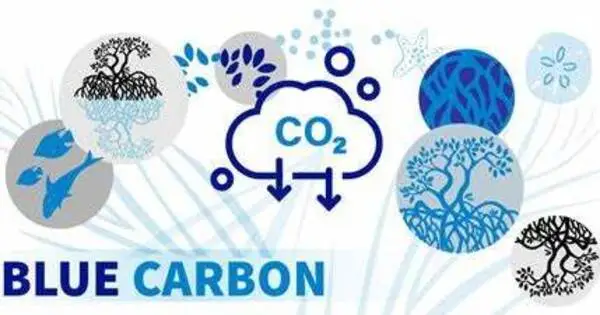Blue carbon is a term used in climate change mitigation to refer to “biologically driven carbon fluxes and storage in marine systems that are amenable to management.” It refers to the amount of carbon stored in coastal and marine ecosystems, particularly mangroves, seagrasses, and salt marshes. It is most typically used to describe the role of tidal marshes, mangroves, and seagrasses in carbon sequestration.
Such ecosystems can help to mitigate climate change while simultaneously promoting ecosystem-based adaptation. Blue carbon ecosystems decay or disappear, releasing carbon into the atmosphere. These ecosystems are extremely adept in capturing and storing atmospheric carbon dioxide (CO2) through photosynthesis, which results in the accumulation of organic carbon in their biomass and sediment.
Blue carbon management methods can be grouped into ocean-based biological carbon dioxide removal (CDR) methods. They are a type of biologic carbon sequestration.
Here’s a brief overview of the three main types of blue carbon ecosystems:
- Mangroves: Mangrove forests are found in coastal areas with brackish water and consist of salt-tolerant trees and shrubs. These ecosystems store carbon in both above-ground biomass and below-ground roots and sediments.
- Seagrasses: Seagrasses are marine plants that form meadows in shallow coastal waters. Like mangroves, seagrasses capture and store carbon in their plant tissues and in the sediments where organic matter accumulates.
- Salt Marshes: Salt marshes are coastal wetlands that are flooded and drained by tides. They are characterized by salt-tolerant grasses and other vegetation. Salt marshes also sequester carbon in their biomass and sediments.
Importance
The importance of blue carbon stems from its possible contribution to climate change mitigation. These coastal ecosystems sequester a significant quantity of carbon, playing an important role in extracting CO2 from the atmosphere and storing it for extended periods. When these ecosystems are degraded or destroyed, the stored carbon is released back into the atmosphere, increasing greenhouse gas emissions.
There is a growing interest in discovering blue carbon potential. The research is ongoing. In some circumstances, these ecosystems have been shown to extract carbon at ten times the rate of mature tropical forests. However, the long-term usefulness of blue carbon as a carbon dioxide removal strategy is still debated. The term “deep blue carbon” refers to initiatives to store carbon in deep ocean waters.
Conserving and restoring blue carbon habitats is consequently regarded as an important strategy for both climate change mitigation and biodiversity conservation. Efforts to safeguard these places frequently include sustainable management techniques, policy measures, and international collaboration to combat challenges such as coastal development, pollution, and climate change effects.
















